Nordhouse Dunes ecology
2016-11-20
Here's a panoramic photo of some of the dunes (click through to really see it)

We spent a week near Nordhouse Dunes in northern Michigan, on the edge of lack Michigan. We went on a number of dayhikes, just enjoying the interesting ecology. It was actually highly varied. A lot of it was wooded, some was hardwood forest like below

But there was also white pine forests and red pine forests. In the more open areas ferns grew everywhere and probably the most wintergreen I've ever seen.
The bare dunes are out by the water where supposedly there are plovers that run up and down the beach... though they are very hard to spot (we never saw any).
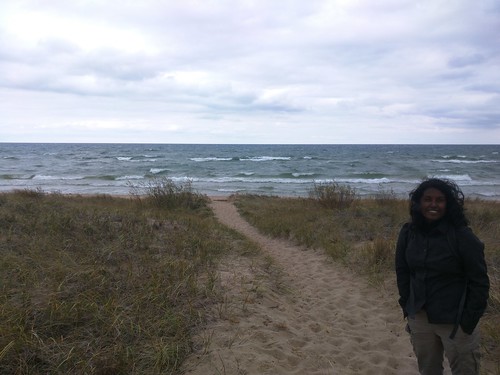
We saw several plants we only recognized due to picking seeds on Adam's farm. It's amazing how once you've worked with a plant a little you start seeing it everywhere
I *think* this is a liatris, I'm more sure about the one next to it. I suspect they are the same, but I'm not certain.

And this looks like an interesting goldenrod
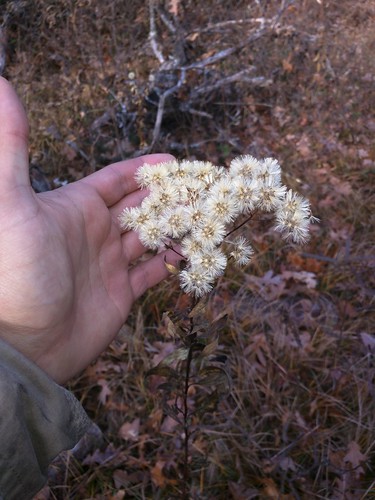
Both plants we helped gather at Adam's
We also saw aster, and either dolls-eye or a close relative, out on the open dunes. Sadly I didn't get pictures of those.
We ended up bushwhacking out to a dry lake bed

The mud was just covered in tracks. below are a bunch of what I think are coon prints. We stared at some other prints for a long time and I kept thinking they must be mustilid of some kind (I believe it had 5 toes on both sets of feet, and the hind foot seemed to be in the rear), but I'm still not sure. Sadly I didn't get a photo of those.

The bare dunes were good for prints too. I think are just a squirrel that didn't put down it's heal on it's hind feet.
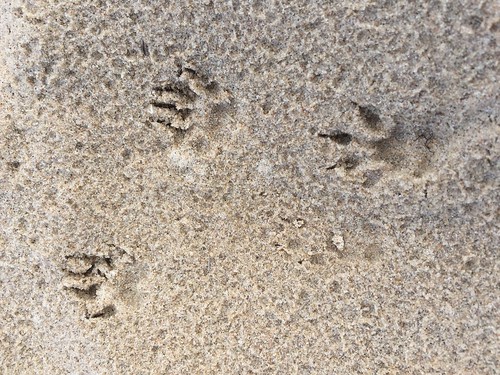
I guess I didn't mention the beech trees, which were just amazing colors.

We camped in the site above for the whole week, a nice hiking distance from the water before moving to another part of michigan for the next week. The nordhouse dunes were pretty gorgeous at this time of year and we were lucky to get there just before the leaves finished the show.
Dutch Oven Baking tricks
2016-11-20
Angie has been doing some AWESOME baking with the dutch oven lately. She made a couple of batches of cookies, as well as bread pudding, and I made a finish pancake. A friend asked us to share whatever tricks she used to get that all to come out so well.
Here's some cookies. These are supposed to be backed at ~350F. We don't have an *actual* dutch oven, just a nice cast-iron cookpot with a lid, so she turned the lid upside down and dumped coals in it using a small shovel.
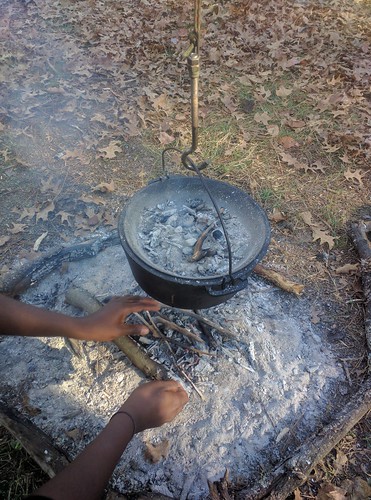
To keep it going for things that take a little while she throws small sticks on the coals that burn as well, keeping the coals a little more alive so they don't slowly die off. Having the pot hanging from a tripod rather than directly in the fire lets her control the heat of the bottom of the pot without having to super carefully manage the fire and coals. This makes it much easier to avoid burning the bottom of the cookies
Here's the rather delicious results.
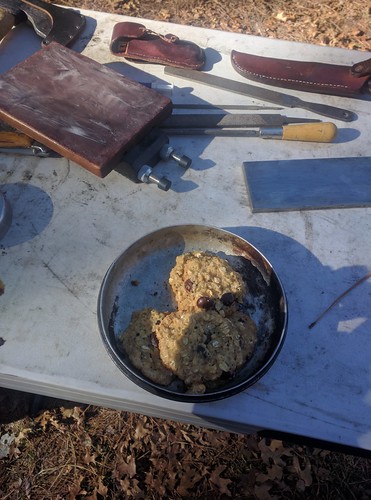
Here's my finish pancake cooking. Notice that we dumped a lot more coals on top of the pot, and the fire is a little hotter and/or the pot is closer to the fire. Finnish pancake is supposed to bake at ~450F. We probably got it a little over that because it cooked in the "expected" time... but it was much thicker than the recipe recommends

This was my second time making finish pancake over a fire... The first time we did it at my friend's place using a grating. The bottom of the finish pancake burned slightly because the fire under it was too hot. It still came out good, but not nearly as perfect as this one did.
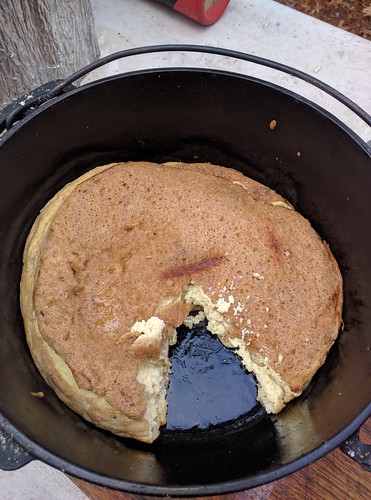
Notice how it didn't stick to the bottom at all (it's brown on top because I used whole-wheat flour).
Delicious!
Char Cloth
2016-11-20
Char cloth is a really neat material that helps enormously with starting fires from a spark (or from a small coal). I've been experimenting with it a bit lately and I'm a HUGE fan. It's great stuff if you want to reliably start fires from a spark... particularly a tiny spark like a true flint and steel. Also... it turns out to be stupidly easy to make.
Find some pure cotton material. My first try was bedsheets shown below, but I found T-shirt worked better
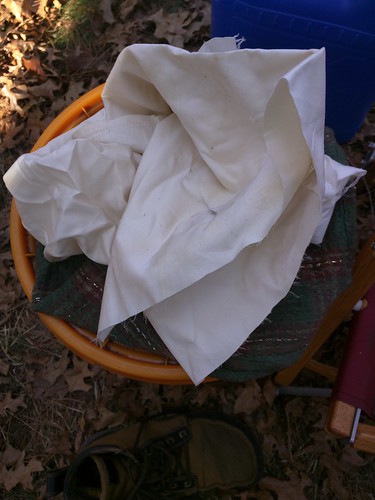
Stick it in a tin that has some small air-holes. An altoids tin has just the right amount of airflow already, so works well. Throw that in the fire for a while. Wait until it stops smoking (and jets of flame stop coming out the hinge), and then wait a while longer. If you don't feel like watching it just throw it in for a couple of hours, it doesn't seem to matter. Pull it out of the fire and set it aside. Don't open it yet.
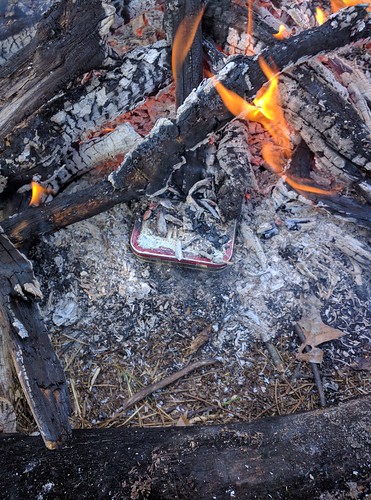
When it's cool open it up. You'll have black material. It's fragile, but still sturdy enough you can pick it up and handle it.

And now you have char cloth.
To use it, take a small pieces, maybe a quarter of one of the pieces shown above. Drop a a spark on it. You'll see that even a tiny spark will make a little red coal that starts spreading slowly across the fabric. with better fabrics it will spread slowly of it's on accord, even with no blowing, worse it'll spread a little and go out unless you blow on it. The difference between the two is fairly significant when you go to use it.

Drop that burning piece of fabric in to your tinder bundle. Here I'm using some fairly dry fern that was common around our campsite in Michigan.
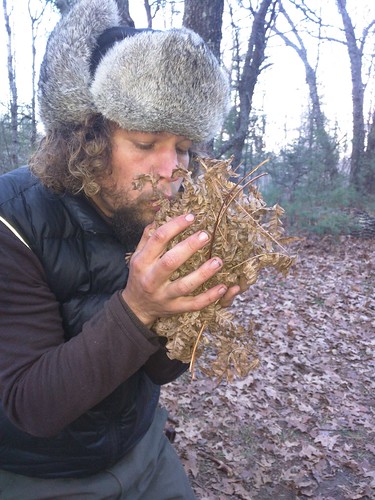
Blow in to the tinder bundle. Focus on getting long continuous streams of air, rather than lots of air fast. Continuous is more important... Increase it a bit as things start to heat up. At some point it'll start to flame up... drop it before you burn your hands.
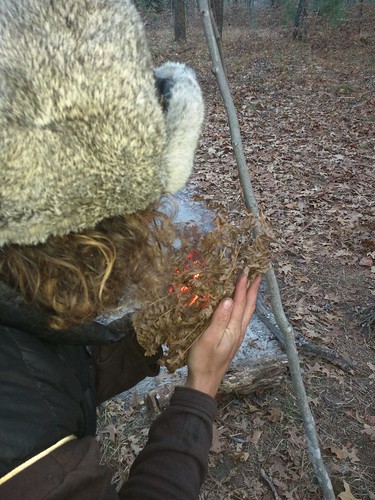
Then use that to light your fire so you can cook.

For the last several days this is how I've started virtually every fire (usually 2 a day). I hadn't really experimented with char-cloth before this, but I'm a big fan.
Just as some other notes on interesting materials for starting fires with a spark. Cat-tail fluff is classic, but I've found the tips flash over really fast and the inner bits never burn... you have to spend a lot of time picking it apart. And it burns fast but not hot, so it's very hard to use it to actually light something else. It's probably good for turning a VERY bad spark in to something you can light with a very good spark, but that's all.
Milkweed on the other hand lights so fast and hard that it can make a little "pop" sound and burns the entire material. It still lights with the tiniest spark, but seems to have enough energy to light something like dry ferns.
Bow-drill and handrill is really neat, but I've never spent the energy to get good enough at them. Matches are a great backup, but you run out quickly. Lighters work well, but are very hard to use in the cold, and often won't light if they've gotten wet enough. Sparkers always work, you can get thousands of sparks off a single stick, and they are fast and easy... the only problem is you need good tinder.
Backpacking in the Ozarks
2016-11-10
Angie and I did a 3 day (2 night) section of the Ozark trail.
Gear:
I was playing with interesting gear. Here's a picture of the gear I carried:
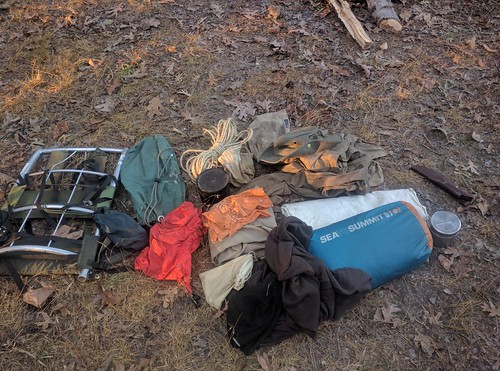
- Rafia rope (used for bearbagging, and tying gear to pack)
- Not quite complete waxed-cotton poncho
- Alpaca fur sleepingbag in E-Vent drysack
- Stakes in a cotton bag
- Wool sweater
- Second wool sweater
- Waxed cotton-polyester canvas shirt
- Cotton canvas hat
- Titanium cookpot
- Bushbuddy woodstove
- Kleen-kanteen stainless steel food container (as water bottle)
- Antique external frame pack
- Knife in leather sheath
- 3 cotton bandanas
- "emergency" kit (firestarting, etc.)
- cotton-poly blend 5.11 pants
- wool darn-tough socks
- leather shoes
The straps pictured on the pack were left behind in favor of practicing with non-plastic rope.

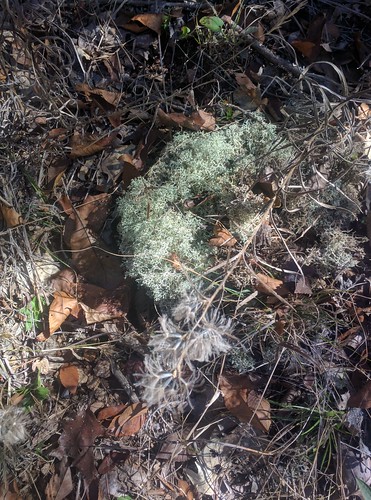
We found that we could use puff from a local plant, not sure what it was maybe a golden-rod of some kind? to catch the spark. Then we could use a lichen as a coal extender so it would burn long enough to light sticks. This worked quite well, but only if the lichen was dry enough... so we tried to store it so it would be dry when we went to use it. Dew was sometimes enough to dampen it too much, sometimes it was still okay.
Johnson shutins was gorgeous. We'd actually been there earlier, but it was great to go back.We almost just stopped there and stayed for a day
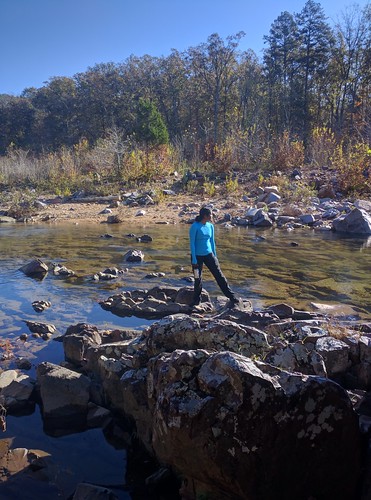
A nice campsite and delicious food. We split cooking so I could practice with the wood stove, and because our two pots weren't large enough to cook all the food I brought. I've been eating a LOT lately so I carried double dinner for myself. We discovered that I need a larger cookpot :P

This is the "scour". That line above is an incomprehensibly large damn wall surrounding a reservoir on top of a large hill. Some years ago it burst and flowed down carving a huge scour out of the ground on it's way through. The restitution they payed for the damage done was used to rebuild all the human components of Johnson Shutins. That wall was just amazing to look at. It's a long way away still in this photo. I'd seen it on our drive in and yelled my surprise to Angie as we rounded to top of a hill but it was too late for her to see it. This was her first view.
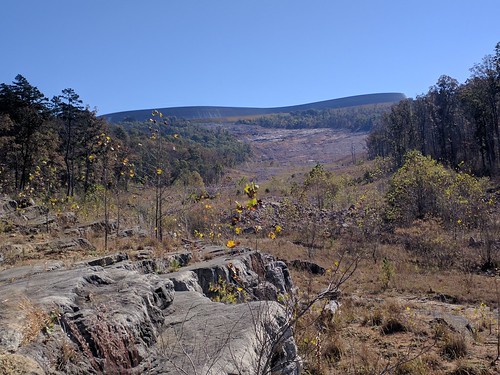
At the other end we stuck out our thumbs for a hitch. I was curious to see how it went in Missouri. It took half an hour but a really really sweet guy picked us up and decided to drive us all the way back to our car (not what we expected or were even hoping for, but we were very thankful). Nothing like hitchhiking to meet the nicest people.
A great trip. Angie and I definitely fell in love with Missouri while we were there. it's quite the beautiful place.
Ecological Restoration with Adam Weiss
2016-10-19
A while back Angie and I met our friend Adam Weiss at the Rivercane gathering in Georgia. We ended up going on all the plant-walks together and Adam told us about his work in ecological restoration. We decided we had to visit him in the Ozarks.
And so, we made a stop by the Ozarks on our way west. What he showed us was pretty amazing.
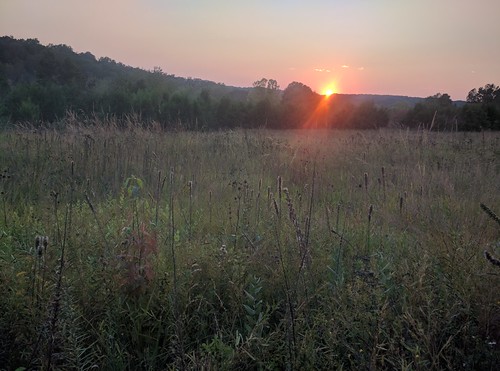
The photo above is one of Adam's fields, a Prairie that Adam re-established on his farm. He manages the fields with fire, burning them regularly. He's gotten so good at it that he does it for a living managing other people's land as well. The bio-diversity of these fields is amazing. Herbs, food, and fiber plants growing all over the place.
A while back while I was at the Buckeye gathering in California Cat Anderson (the author of "Tending the Wild") came to speak. Everyone there was ecstatic because they'd all read Tending The Wild, and all had been convinced by it that human's are fundamentally a part of the ecosystem. For many, myself included, this book changed their view of people as only destroyers of the world, to that of keepers, even gardeners, of it. Her book establishes in an academically rigorous manner that human's have played a major role in the ecosystem for many thousands of years, long enough that we are now an integral part of it... Thus, if we simply "leave it alone" it will not return to it's natural state, because we are a PART of it's natural state.
At this gathering though, everyone waited with baited breath for Cat Anderson to tell them *how* to do that. She stood up in front of the crowd and explained she didn't know... she'd been hoping that we could tell her how to do it. A hush ran over the crowd as it hit us all that there was a much longer path than any of us had realized... there was no-one to teach us, we had to figure this out ourselves.
Adam on the other hand, seems to have figured out a piece of this puzzle. He's doing the same with forests as well, using fire, removing invasives, thinning forests into woodland, and re-establishing the old ecologies again. There are other people establishing "Prairie" as well, but Adam is the only one anyone has heard of who is using local seed, or who's prairie come out so diverse. Basically... he's farther along in re-establishing real ecologies, than anyone else I'm aware of. If you've read at all about "land-race" verities of plants (e.g. corn, they discuss this in 1984, which is also great background for this post), you'll understand why local verities matter. He gathers wild seeds from tiny patches of natural prairie he finds locally, plants them on his farm, and then gathers the seeds from that and plants them elsewhere. As a result his prairie is truly natural Missouri prairie, surviving better, and out-competing the invasives better.
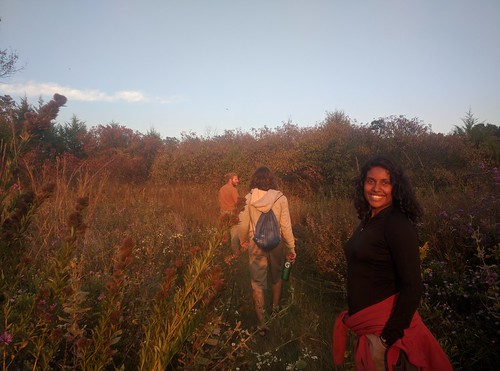
Angie and I met a couple of Adam's other friends, and helped him harvest some seed.
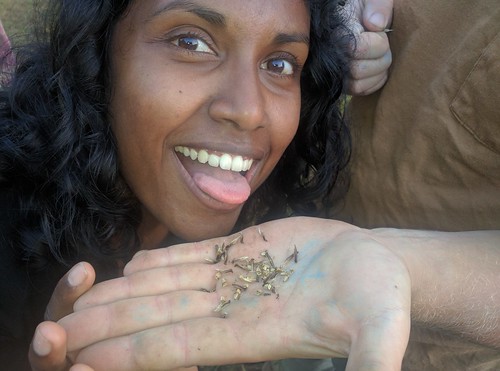
Adam also just happens to be an awesome guy, a botanist and a scientist at heart, so he was just a blast to hang out with. But I'm completely non-apologetic in my trying to suck every bit of knowledge I can out of his brain while with him. We need more people doing this sort of thing.

The main lesson I've learned from talking to him though is that there is no magic bullet for re-establishing ecologies. What people wanted at that gathering was a quick answer, a solution. There isn't one that would fit in a talk. When I asked Adam how he figured out what to do, where he learned it, he said that he learned all the plants, and just started trying to do it. He watched the results and learned.
So, there are no true shortcuts... but maybe a few folks like Adam can be a bit of a shortcut for the rest of us.

